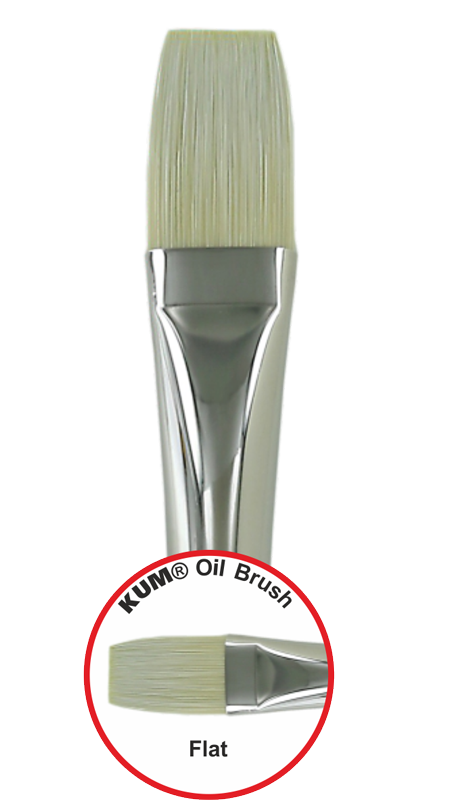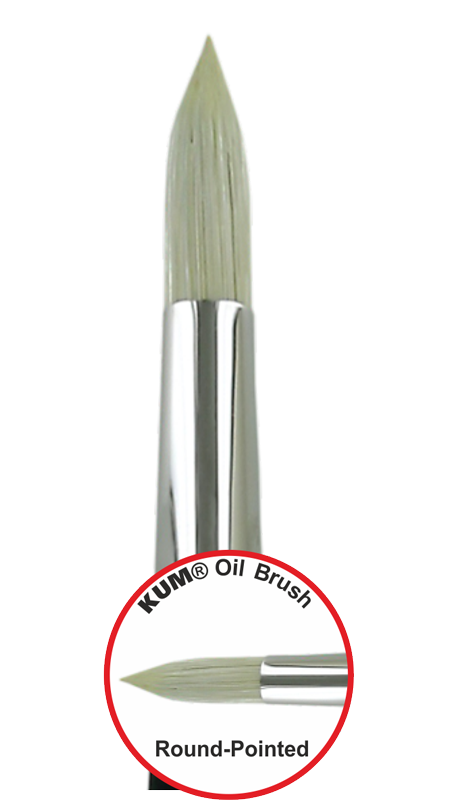KUM Pinsel für Acryl- und Ölmalerei
-
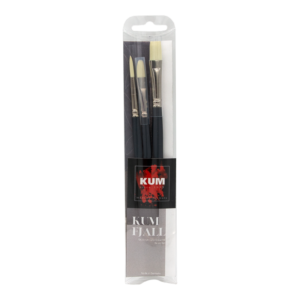
Pinselset Fjall
€44,90
Enthält 19% MwSt.zzgl. Versand -
Angebot!
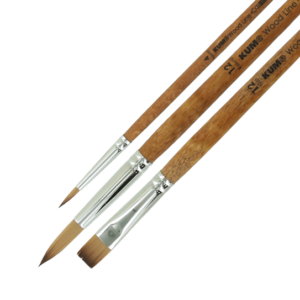
KUM Wood Line Acryl Set
Ursprünglicher Preis war: €38,57€30,85Aktueller Preis ist: €30,85.
Enthält 19% MwSt.zzgl. Versand -
Angebot!
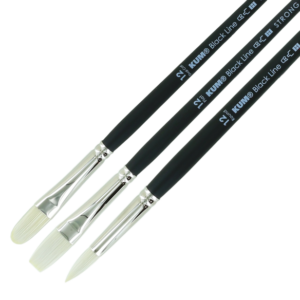
KUM Black Line
€6,23 – €41,91
Enthält 19% MwSt.zzgl. Versand -
Angebot!

KUM Wood Line
€4,79 – €26,79
Enthält 19% MwSt.zzgl. Versand
Das richtige Material ist der Grundstein für die Acryl- und Ölmalerei, denn alles steht und fällt mit der Grundausstattung. Mit welchen Pinseln und allgemein Materialien du am besten klarkommst weißt du erst, wenn du sie testest. Daher schaffe dir lieber eine ordentliche, als eine zu ausschweifende Erstausstattung an. Beim Malen wirst du schnell feststellen, was deiner Sammlung noch fehlt.
Für welche Farben sind die Pinsel geeignet?
Grundsätzlich bestehen Farben primär aus Farbpigmenten und Bindemittel. In Acrylfarben werden die Farbpigmente durch Acrylharzteilchen gebunden und die Konsistenz kann durch das Beimischen von Wasser verändert werden. Im Gegensatz dazu basieren Ölfarben nicht auf Wasser, sondern auf Öl und können daher nicht mit Wasser verdünnt werden. Als Bindemittel wird hier meistens Leinöl verwendet. Beide Arten von Farben haben eine dickflüssige Konsistenz, für welche härtere Pinsel benötigt werden, um die Farben gut verstreichen zu können.
Welche Eigenschaften sollte ein Pinsel für Acryl- und Ölmalerei haben?
Grundsätzlich hängt die Wahl der Pinsel und seine Eigenschaften stark von dem Effekt ab, den du mit ihnen erzielen möchtest. Borstenpinsel sind sehr hart und dadurch nur für einige bestimmte Techniken und Striche geeignet, beispielsweise erreichst du mit ihnen den Effekt von mehr Struktur, wie sichtbaren Streifen und Abdrücken. Synthetische Pinsel sind wesentlich weicher und damit vielseitiger und kreativer einsetzbar. Im Vergleich zu Aquarellpinseln sollten sie widerstandsfähiger und weniger flexibel sein, um die schwere Farbe bewegen zu können.
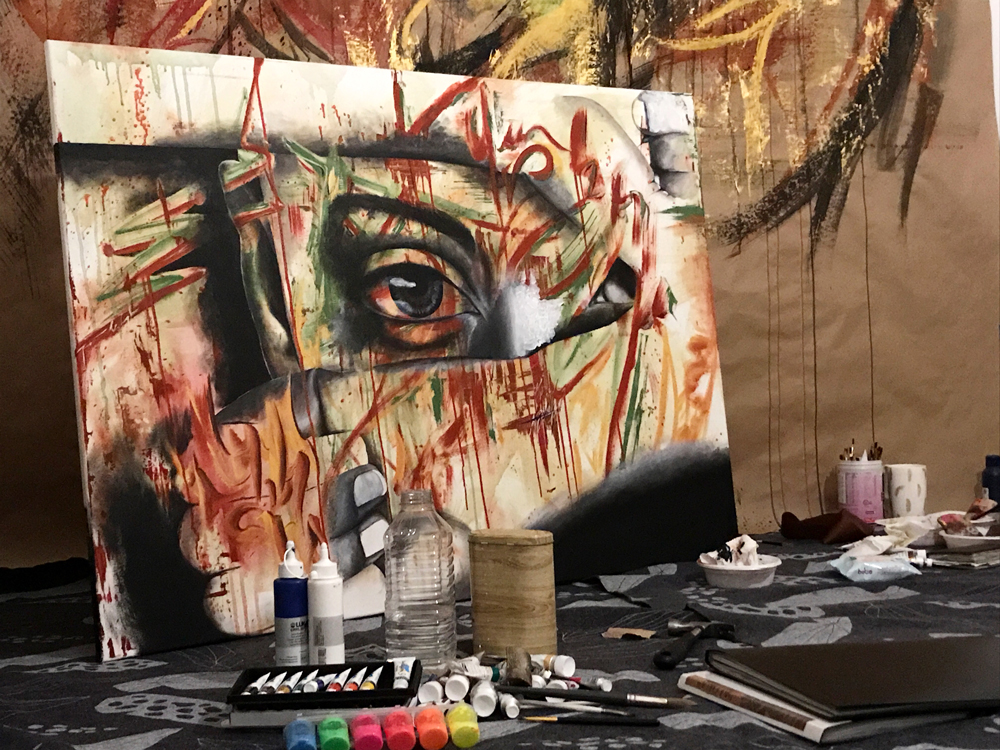
©Mira Monet instagram.com/mira.monet
Synthetikfaser oder Echthaar?
Echthaarpinsel bewähren sich seit Jahrhunderten und haben einen guten Ruf. Allerdings sind diese auch sehr kostspielig und gerade in einer Zeit, in der der Tierschutz immer mehr an Bedeutung gewinnt, stellt sich die Frage nach alternativen Pinseln. In den letzten Jahren wurden Synthetikfasern immer weiter entwickelt und sind mittlerweile kaum noch von Echthaarpinseln unterscheidbar. So sind Pinsel mit Synthetikfasern nicht nur eine preisgünstige, sondern auch gute und vegane Alternative. Zum Teil können die Synthetikfasern aber auch die echten Haaren übertreffen, da sie sich beispielsweise leichter reinigen lassen.
Welche und wie viele Pinsel sind als Anfänger sinnvoll?
Ein kompletter Satz an Pinseln ist für den Anfang absolut nicht notwendig. Wenn du noch nicht genau weißt, was du malen möchtest und du erst einmal ein Gefühl für das Malen mit Acryl- bzw. Ölfarben bekommen möchtest, macht eine kleine, durchgemischte Auswahl an Pinseln mit verschiedenen Formen am meisten Sinn. Eine gute Basis bilden ein Flachpinsel, ein Rundpinsel und ein Katzenzungenpinsel. Du hast damit eine gute Mischung, um dich in von Landschafts- bis Portraitmalerei auszuprobieren und die Vorteile der jeweiligen Pinselform kennen zu lernen.
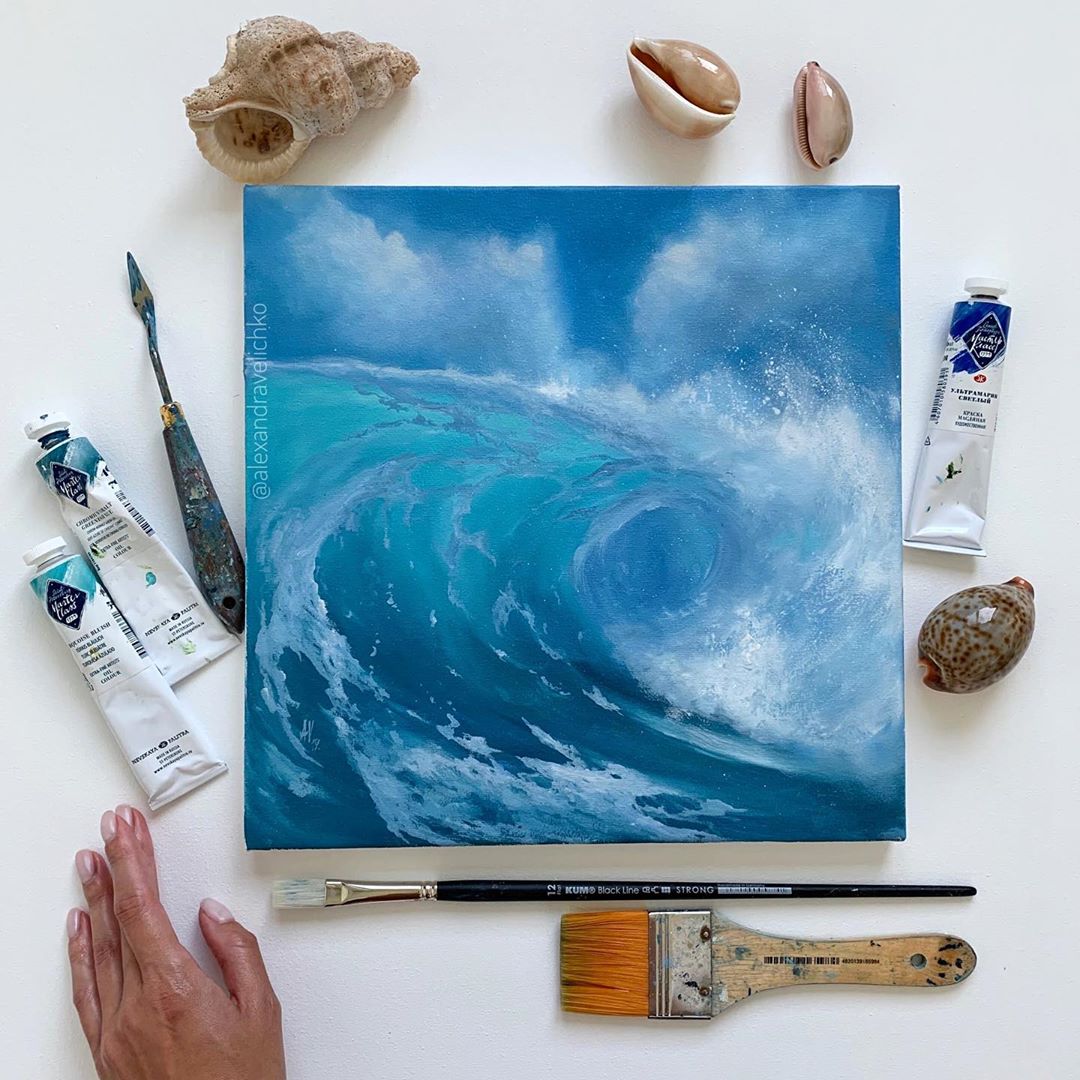
©Alexandra Velichko instagram.com/alexandravelichko
Worin unterscheiden sich die KUM Black Line und KUM Wood Line Pinsel?
Die Wood Line und Black Line Pinsel unterscheiden sich hinsichtlich ihrer Flexibilität bzw. Federung. Warum es weichere und festere Pinselköpfe gibt, liegt an den unterschiedlichen Konsistenzen und dem Gewicht der Farben. Ölfarbe beispielsweise ist eine schwere Farbe, daher eignen sich weniger flexible Pinsel am besten. Die Black Line Pinsel sind in ihrer Federung etwas stärker als die Wood Line Pinsel, es lässt sich also schwerere Farbe besser bewegen. Grundsätzlich sind aber alle aufgeführten Pinsel für sowohl Acryl- als auch Ölmalerei sehr gut geeignet.
Sollten die Pinsel einen langen oder kurzen Stiel haben?
Beim Malen mit Acryl- und Ölfarben bevorzugen viele es vor einer Staffelei zu sitzen oder zu stehen, anstatt das Kunstwerk flach auf dem Tisch liegen zu haben. Ein langer Pinselstiel ermöglicht das Malen mit etwas Abstand zum Kunstwerk und der Staffelei. Da sowohl die Pinsel der Wood Line, als auch die der Black Line für das Malen an einer Staffelei gedacht sind, haben sie lange Stiele.
Wie wichtig ist die Qualität des Pinsels?
Gerade als Anfänger ist es schwierig herauszufinden, welchen Pinsel man kaufen soll. Auch wenn man Malen ‚nur mal ausprobieren‘ möchte, ist es trotzdem wichtig, auf eine ordentliche Qualität zu achten, da schlecht gemachte Pinsel auf so unterschiedliche Weise frustrieren können. Die Freude am Malen vergeht, wenn Pinsel ihre Haare verlieren, sich kaum reinigen lassen oder zu schnell hart werden.
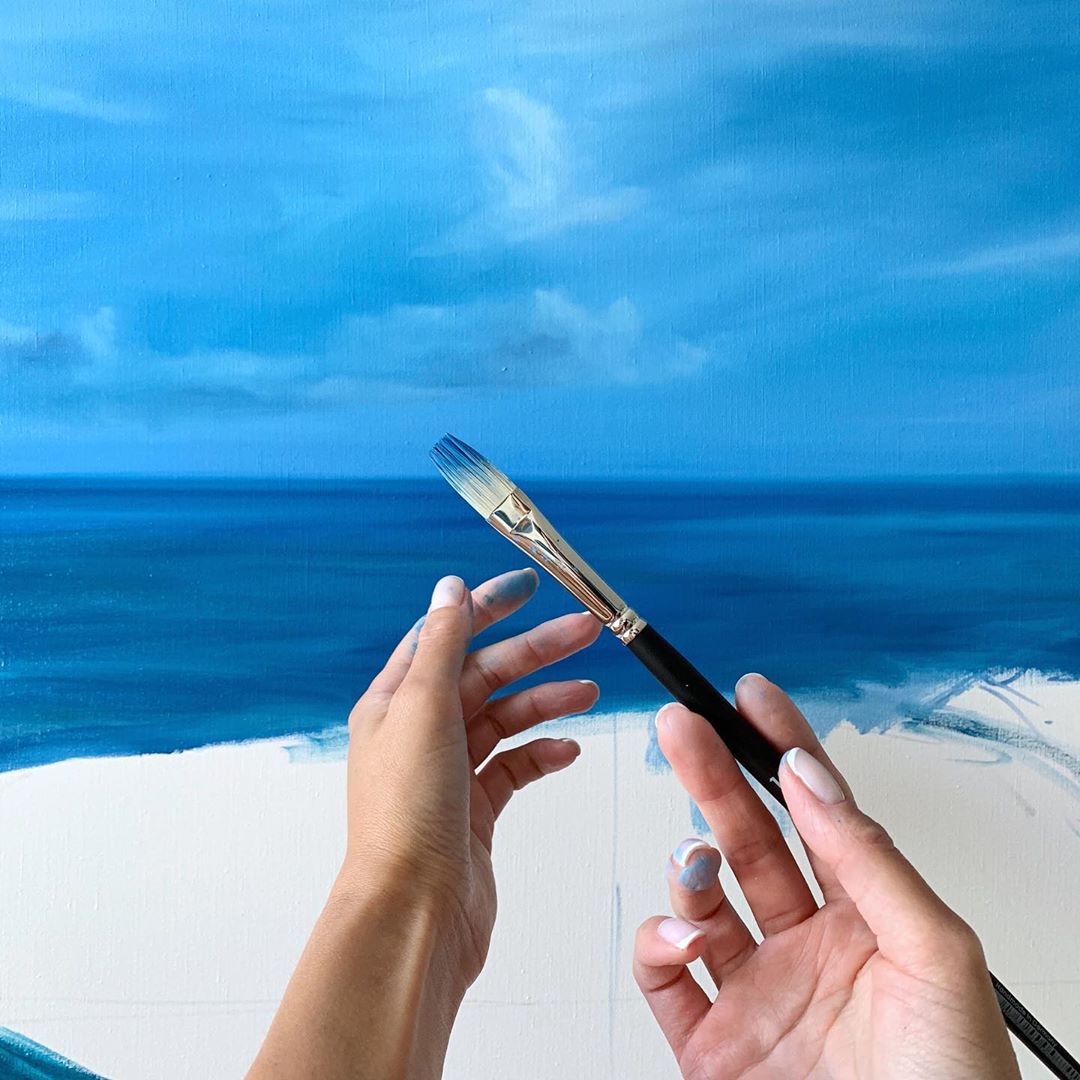
©Alexandra Velichko instagram.com/alexandravelichko
Aniko Boda about KUM Black- and Woodline
Anikó Boda studierte nach ihrem Medizinstudium Malerei in New York. Sie stellte in bekannten Museen und Galerien weltweit aus und wurde 2021 als eine der 400 besten Porträtmaler ausgezeichnet. 2023 war sie Finalistin im Salon-Wettbewerb des Art Renewal Center in New York und wurde in der Zeitschrift Fine Art Connoisseur vorgestellt. Ihre Trompe-l’oleil-Gemälde, beeinflusst von Odd Nerdrum und Michael Trieger, kombinieren traditionelle Techniken mit experimentellen Ansätzen und behandeln philosophische und psychologische Fragen der menschlichen Existenz.
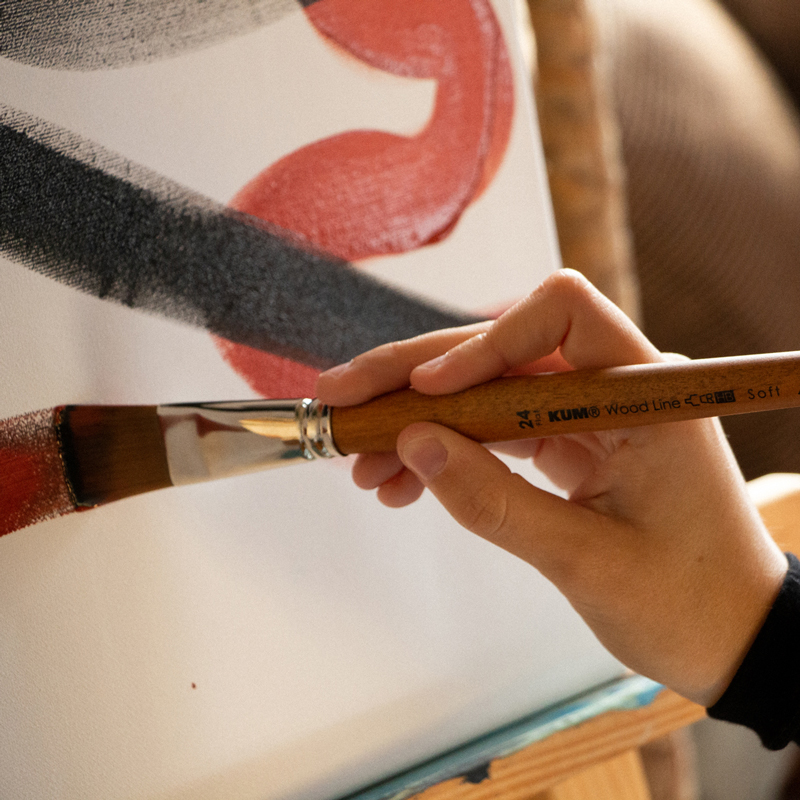
KUM Wood Line
langstieliger Pinsel speziell für die Acrylmalerei, auch für die Ölmalerei geeignet
–
Härtegrad medium-soft
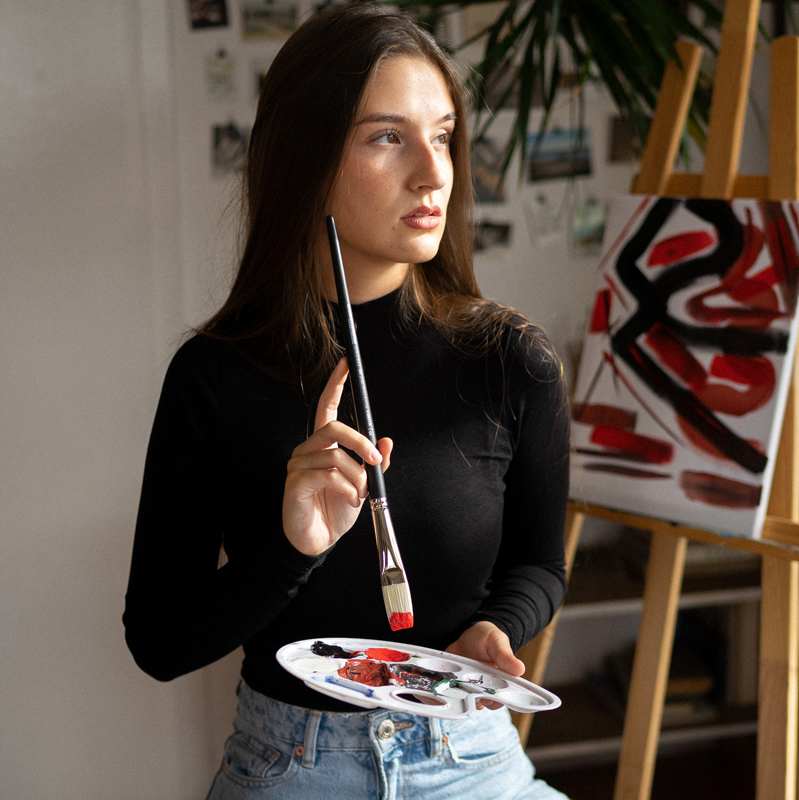
KUM Black Line
langstieliger Pinsel speziell für die Ölmalerei, auch für die Acrylmalerei geeignet
–
Härtegrad strong
Mit welchem Pinsel wird was genau gemalt?
Flach
Die flache Variante ist besonders gut geeignet zum Verteilen von Farbe und Malen von gleichmäßigen Flächen und Lasieren. Die Form eignet sich außerdem perfekt, um Ecken auszuarbeiten. Mit der Pinselkante können zudem feine Linien gezogen werden.
Rund
Durch die feine Pinselspitze lassen sich die kleinsten Details umsetzen. Gleichzeitig wird durch die Vielzahl an dicht nebeneinanderliegende Haare eine besonders gute Speicherung der Farbe garantiert. Dadurch können größere Flächen und Farbverläufe schnell und einfach erzeugt werden.
Katzenzunge
Die breite, spitz zulaufende Form vereint die Vorteile der flachen und runden Variante. Das macht katzenzungenförmige Pinsel besonders vielseitig nutzbar. Die Form ermöglicht dem Künstler sowohl einen gleichmäßigen Farbauftrag und weiche Farbübergänge, als auch das Malen von Linien und feinen Details. Zusätzlich eignet sie sich ideal zum Ausarbeiten von runden Formen.
Welche Utensilien werden zum Malen noch benötigt? / Welche Grundausstattung ist sinnvoll?
In der Zusammenstellung deiner Grundausstattung reicht eine kleine Ausstattung an Materialen zu Beginn völlig aus.
Für die Acrylmalerei benötigst du neben den Pinseln weiterhin:
- Acrylfarben – Schwarz, Weiß und die drei Basisfarben Gelb, Blau und Rot (damit lassen sich unzählige weitere Farbtöne ganz einfach mischen)
- Farbpalette
- Maluntergrund – gängige Untergründe sind beispielsweise Leinwände, Holzplatten, Glas, Pappe oder Papier
- Grundierung – damit die Acrylfarbe auf dem Untergrund gut haftet, ist es sinnvoll den Maluntergrund vorher mit einer Grundierung einzupinseln
- Staffelei – ist von Vorteil, wenn du lieber aufrecht malst
Für die Ölmalerei benötigst du neben den Pinseln weiterhin:
- Ölfarben – Schwarz, Weiß und die drei Basisfarben Gelb, Blau und Rot (Tipp: achte auch bei den Farben auf gute Künstlerqualität, günstige Farben decken oft weniger gut, enthalten weniger Farbpigmente und können nach dem Trocknen porös werden)
- Farbpalette – meist aus Kunststoff oder Holz zum Mischen der Farben
- Malgrund – Leinwände aus Baumwolle oder Leinen (Tipp: Baumwolle ist absolut ausreichend und deutlich günstiger als Leinwände aus Leinen), aber auch Holzplatten
– für den Anfang ist Malpappe auch ausreichend, um verschiedenste Techniken auszuprobieren - Grundierung
- Leinöl – zum Verdünnen der Farben
- Terpentin – damit lassen sich die Pinsel nach dem Malen wieder reinigen
- Staffelei
Was ist bei der Ölmalerei zu beachten?
Erstmal grundlegend zur Ölmalerei: das Malen mit Ölfarben ist nicht so einfach und sauber wie beispielsweile mit Aquarellfarben. Ölfarben sind grundlegend anders, die Farben schmieren, lassen sich nicht mit Wasser vermalen, stinken und können hässliche Flecken hinterlassen. Und trotzdem hat das Malen mit Ölfarben einen eigenen Reiz mit ganz anderen Möglichkeiten.
Aufgrund der Farbe ist es wichtig in einem Raum zu malen, der sich gut lüften lässt, oder direkt draußen zu malen. Außerdem solltest du darauf achten beim Malen nur alte Klamotten zu tragen und eine Unterlage auszulegen.
Wenn du dich für das Malen auf einer Leinwand oder Holzplatte entscheidest, sollte du sie vor dem Malen erst grundieren. Das ist nicht nur bei selbst aufgespannten Leinwänden nötig, sondern auch bei bereits vorgrundierten, gekauften Leinwänden. Die Qualität und Haltbarkeit werden maßgeblich von der Grundierung beeinflusst, da die Oberfläche durch die Grundierung geschlossen wird und den Farben beim Auftragen das Öl nicht entzogen wird. Entscheidest du dich für den Malkarton, benötigst du keine Grundierung.
Ölfarbe trocknet im Vergleich zu anderen Farben sehr langsam. Durch das Zumischen von Malmitteln lässt sich die Trocknungszeit verringern, aber die es bringt doch auch Vorteile mit sich, wenn die Farben lange brauchen um zu trocknen. Ob es sinnvoll ist Malmittel dazu zumischen ist maßgeblich davon abhängig mit welcher Technik du malen möchtest. Bei der Nass in Nass Technik wird dein gesamtes Bild nur aus einer Schicht bestehen und du kannst den langsamen Trocknungsprozess gut nutzen. Die Farben trocknen tatsächlich so langsam, dass du zwischendurch auch Pausen einlegen kannst. Wenn du jedoch Schicht über Schicht malen möchtest, muss jede Schicht bevor du eine neue aufträgst gut getrocknet sein. Um dem Trocknen da etwas nachzuhelfen, macht es Sinn den Farben ein Malmittel wie beispielsweise Liquin beizumischen. Die goldene Regel beim Auftragen von Schichten ist: fett auf mager. Das bezieht sich auf den Ölanteil in deinen Farben. Um Risse zu vermeiden, sollte in den oberen Farbschichten immer mehr Öl zugemischt werden. Aber keine Sorge, egal wie stark du die Farben verdünnst, die Farbpigmente ändern sich nicht. Beachte auch, dass je nach Dicke deiner Schicht(en) es mehrere Tage dauern kann bis dein Bild trocken ist.
Was ist bei Acrylmalerei zu beachten?
Insgesamt gibt es nur wenige Punkte, die bei der Acrylmalerei zu beachten sind. Da aber auch Acrylfarbe sich aus Kleidung nicht mehr auswaschen lässt, ist es sinnvoll alte Kleidung zu tragen und auch eine Unterlage auszulegen. Zum Mischen der Farben ist eine kleine Palette von Vorteil, die kann aber auch aus einem alten Teller oder einer kleinen Holz- oder Kunststoffplatte bestehen.
Da Acrylfarbe sehr schnell trocknet, sollte immer nur so viel Farbe aus den Tuben gedrückt werden, wie benötigt wird, da die Farbe sonst schnell unbrauchbar wird. Um die dickflüssige Farbe zu verdünnen, kannst du einfach etwas Wasser hinzufügen. Je nach Technik wird gar kein, mehr oder weniger Wasser den Farben beigemischt.
Bei der Lasurtechnik wird der Farbe viel Wasser hinzugefügt, um die Deckkraft der Farben zu reduzieren. Diese Technik wird häufig für Hintergründe verwendet oder um durch das Schichten optische Farbmischungen zu erzeugen.
Um Farbverläufe zu erzeugen wird mit der Lavier-Technik gearbeitet. Hier wird der Malgrund zuvor mit Wasser bemalt und anschließend die Farbe aufgetragen. Um ein ebenmäßiges Ergebnis, ohne sichtbare einzelne Pinselstriche zu erhalten, kann mit einem großen, flachen Pinsel ohne Druck über das Bild gestrichen werden.
Je deckender der Farbauftrag sein soll, desto weniger Wasser sollte der Farbe hinzugefügt werden. Um vollständig deckend zu malen, kann die Farbe auch direkt aus der Tube genommen werden.

